Business Strategy: Impact of Macro Environment and Internal Analysis
VerifiedAdded on 2023/01/18
|13
|3724
|55
AI Summary
This report analyzes the impact of macro environment and internal analysis on the business strategy of J Sainsbury Plc. It includes a PESTLE analysis, SWOT analysis, and application of Porter's Five Forces Model.
Contribute Materials
Your contribution can guide someone’s learning journey. Share your
documents today.
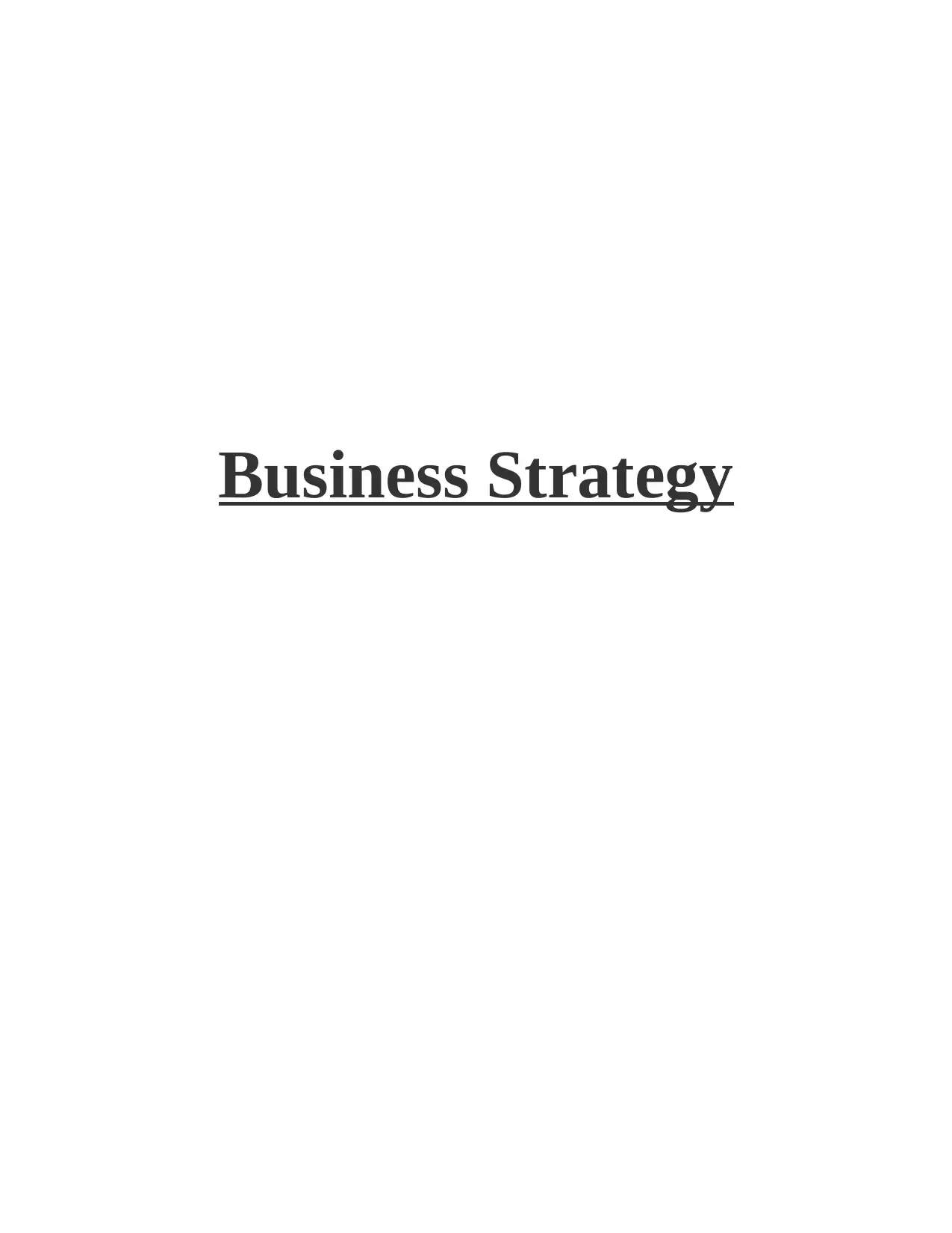
Business Strategy
Secure Best Marks with AI Grader
Need help grading? Try our AI Grader for instant feedback on your assignments.
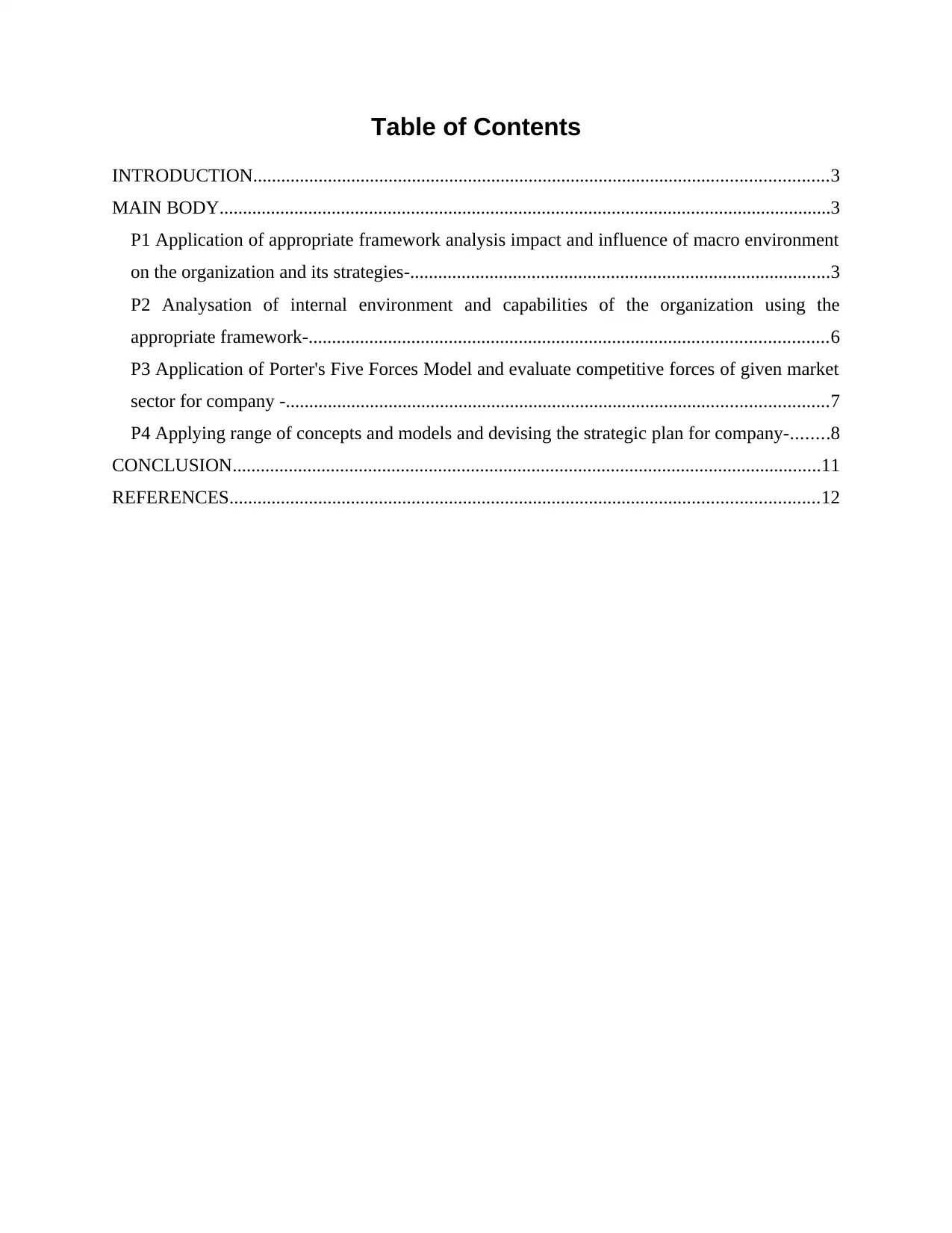
Table of Contents
INTRODUCTION...........................................................................................................................3
MAIN BODY...................................................................................................................................3
P1 Application of appropriate framework analysis impact and influence of macro environment
on the organization and its strategies-..........................................................................................3
P2 Analysation of internal environment and capabilities of the organization using the
appropriate framework-...............................................................................................................6
P3 Application of Porter's Five Forces Model and evaluate competitive forces of given market
sector for company -....................................................................................................................7
P4 Applying range of concepts and models and devising the strategic plan for company-........8
CONCLUSION..............................................................................................................................11
REFERENCES..............................................................................................................................12
INTRODUCTION...........................................................................................................................3
MAIN BODY...................................................................................................................................3
P1 Application of appropriate framework analysis impact and influence of macro environment
on the organization and its strategies-..........................................................................................3
P2 Analysation of internal environment and capabilities of the organization using the
appropriate framework-...............................................................................................................6
P3 Application of Porter's Five Forces Model and evaluate competitive forces of given market
sector for company -....................................................................................................................7
P4 Applying range of concepts and models and devising the strategic plan for company-........8
CONCLUSION..............................................................................................................................11
REFERENCES..............................................................................................................................12
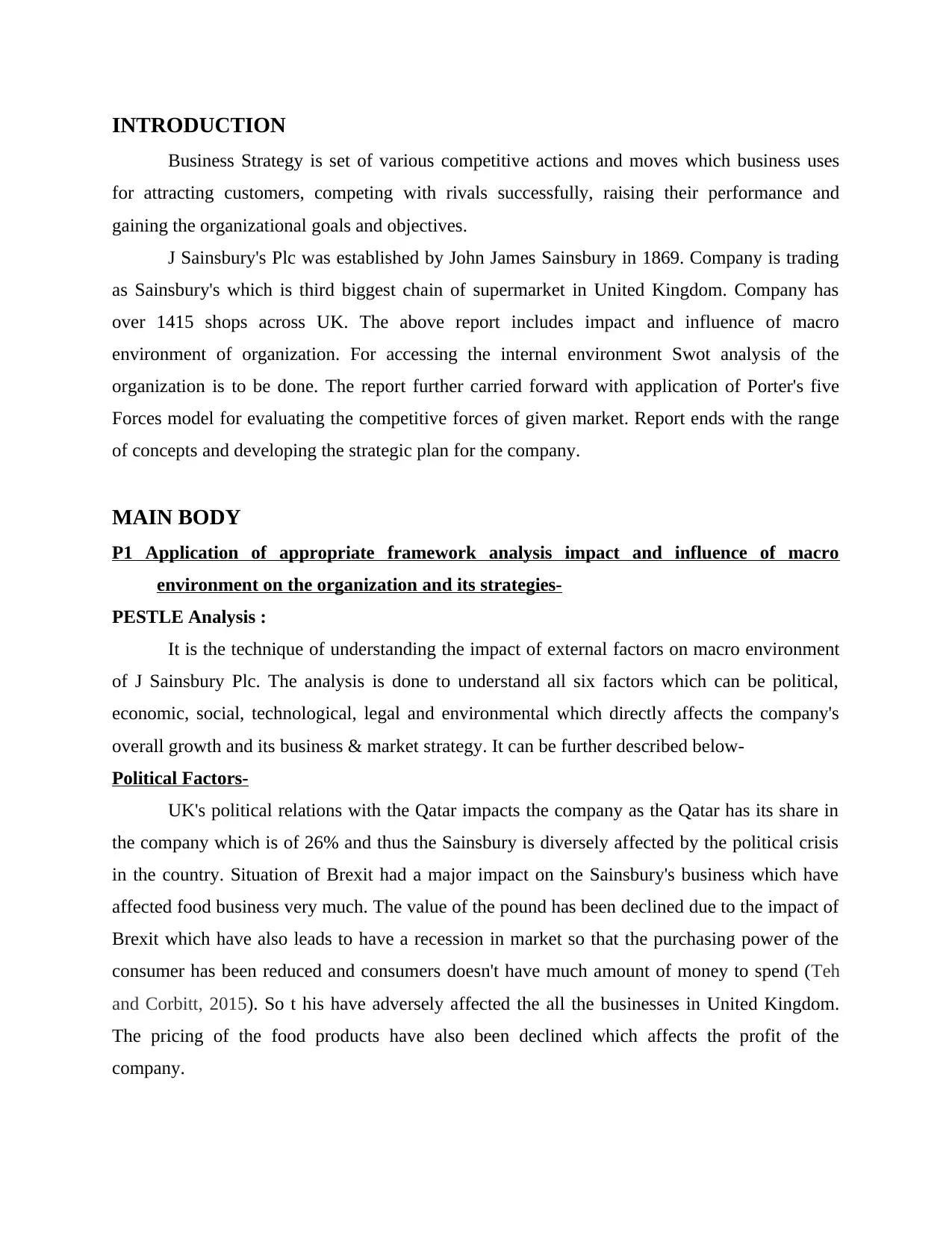
INTRODUCTION
Business Strategy is set of various competitive actions and moves which business uses
for attracting customers, competing with rivals successfully, raising their performance and
gaining the organizational goals and objectives.
J Sainsbury's Plc was established by John James Sainsbury in 1869. Company is trading
as Sainsbury's which is third biggest chain of supermarket in United Kingdom. Company has
over 1415 shops across UK. The above report includes impact and influence of macro
environment of organization. For accessing the internal environment Swot analysis of the
organization is to be done. The report further carried forward with application of Porter's five
Forces model for evaluating the competitive forces of given market. Report ends with the range
of concepts and developing the strategic plan for the company.
MAIN BODY
P1 Application of appropriate framework analysis impact and influence of macro
environment on the organization and its strategies-
PESTLE Analysis :
It is the technique of understanding the impact of external factors on macro environment
of J Sainsbury Plc. The analysis is done to understand all six factors which can be political,
economic, social, technological, legal and environmental which directly affects the company's
overall growth and its business & market strategy. It can be further described below-
Political Factors-
UK's political relations with the Qatar impacts the company as the Qatar has its share in
the company which is of 26% and thus the Sainsbury is diversely affected by the political crisis
in the country. Situation of Brexit had a major impact on the Sainsbury's business which have
affected food business very much. The value of the pound has been declined due to the impact of
Brexit which have also leads to have a recession in market so that the purchasing power of the
consumer has been reduced and consumers doesn't have much amount of money to spend (Teh
and Corbitt, 2015). So t his have adversely affected the all the businesses in United Kingdom.
The pricing of the food products have also been declined which affects the profit of the
company.
Business Strategy is set of various competitive actions and moves which business uses
for attracting customers, competing with rivals successfully, raising their performance and
gaining the organizational goals and objectives.
J Sainsbury's Plc was established by John James Sainsbury in 1869. Company is trading
as Sainsbury's which is third biggest chain of supermarket in United Kingdom. Company has
over 1415 shops across UK. The above report includes impact and influence of macro
environment of organization. For accessing the internal environment Swot analysis of the
organization is to be done. The report further carried forward with application of Porter's five
Forces model for evaluating the competitive forces of given market. Report ends with the range
of concepts and developing the strategic plan for the company.
MAIN BODY
P1 Application of appropriate framework analysis impact and influence of macro
environment on the organization and its strategies-
PESTLE Analysis :
It is the technique of understanding the impact of external factors on macro environment
of J Sainsbury Plc. The analysis is done to understand all six factors which can be political,
economic, social, technological, legal and environmental which directly affects the company's
overall growth and its business & market strategy. It can be further described below-
Political Factors-
UK's political relations with the Qatar impacts the company as the Qatar has its share in
the company which is of 26% and thus the Sainsbury is diversely affected by the political crisis
in the country. Situation of Brexit had a major impact on the Sainsbury's business which have
affected food business very much. The value of the pound has been declined due to the impact of
Brexit which have also leads to have a recession in market so that the purchasing power of the
consumer has been reduced and consumers doesn't have much amount of money to spend (Teh
and Corbitt, 2015). So t his have adversely affected the all the businesses in United Kingdom.
The pricing of the food products have also been declined which affects the profit of the
company.
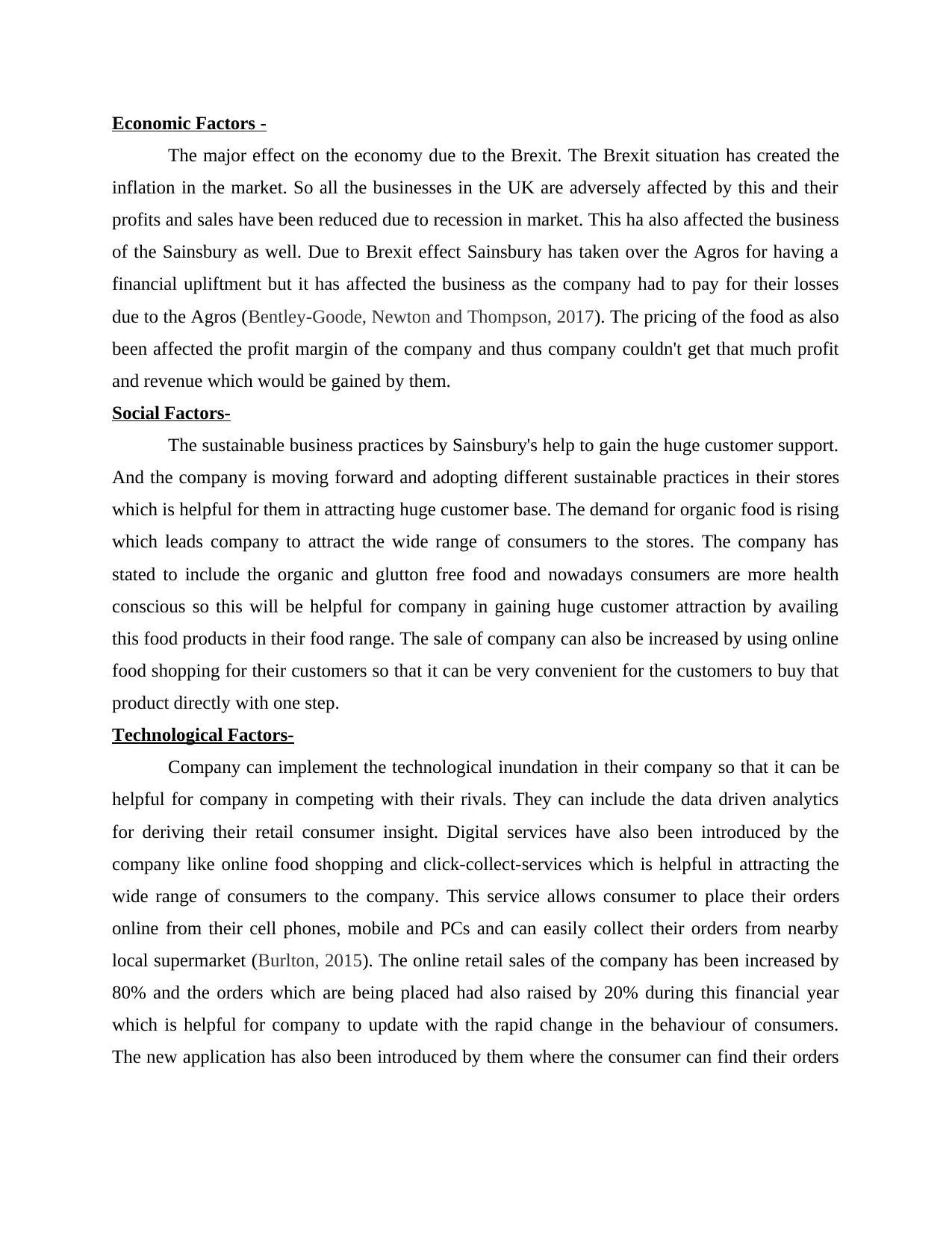
Economic Factors -
The major effect on the economy due to the Brexit. The Brexit situation has created the
inflation in the market. So all the businesses in the UK are adversely affected by this and their
profits and sales have been reduced due to recession in market. This ha also affected the business
of the Sainsbury as well. Due to Brexit effect Sainsbury has taken over the Agros for having a
financial upliftment but it has affected the business as the company had to pay for their losses
due to the Agros (Bentley-Goode, Newton and Thompson, 2017). The pricing of the food as also
been affected the profit margin of the company and thus company couldn't get that much profit
and revenue which would be gained by them.
Social Factors-
The sustainable business practices by Sainsbury's help to gain the huge customer support.
And the company is moving forward and adopting different sustainable practices in their stores
which is helpful for them in attracting huge customer base. The demand for organic food is rising
which leads company to attract the wide range of consumers to the stores. The company has
stated to include the organic and glutton free food and nowadays consumers are more health
conscious so this will be helpful for company in gaining huge customer attraction by availing
this food products in their food range. The sale of company can also be increased by using online
food shopping for their customers so that it can be very convenient for the customers to buy that
product directly with one step.
Technological Factors-
Company can implement the technological inundation in their company so that it can be
helpful for company in competing with their rivals. They can include the data driven analytics
for deriving their retail consumer insight. Digital services have also been introduced by the
company like online food shopping and click-collect-services which is helpful in attracting the
wide range of consumers to the company. This service allows consumer to place their orders
online from their cell phones, mobile and PCs and can easily collect their orders from nearby
local supermarket (Burlton, 2015). The online retail sales of the company has been increased by
80% and the orders which are being placed had also raised by 20% during this financial year
which is helpful for company to update with the rapid change in the behaviour of consumers.
The new application has also been introduced by them where the consumer can find their orders
The major effect on the economy due to the Brexit. The Brexit situation has created the
inflation in the market. So all the businesses in the UK are adversely affected by this and their
profits and sales have been reduced due to recession in market. This ha also affected the business
of the Sainsbury as well. Due to Brexit effect Sainsbury has taken over the Agros for having a
financial upliftment but it has affected the business as the company had to pay for their losses
due to the Agros (Bentley-Goode, Newton and Thompson, 2017). The pricing of the food as also
been affected the profit margin of the company and thus company couldn't get that much profit
and revenue which would be gained by them.
Social Factors-
The sustainable business practices by Sainsbury's help to gain the huge customer support.
And the company is moving forward and adopting different sustainable practices in their stores
which is helpful for them in attracting huge customer base. The demand for organic food is rising
which leads company to attract the wide range of consumers to the stores. The company has
stated to include the organic and glutton free food and nowadays consumers are more health
conscious so this will be helpful for company in gaining huge customer attraction by availing
this food products in their food range. The sale of company can also be increased by using online
food shopping for their customers so that it can be very convenient for the customers to buy that
product directly with one step.
Technological Factors-
Company can implement the technological inundation in their company so that it can be
helpful for company in competing with their rivals. They can include the data driven analytics
for deriving their retail consumer insight. Digital services have also been introduced by the
company like online food shopping and click-collect-services which is helpful in attracting the
wide range of consumers to the company. This service allows consumer to place their orders
online from their cell phones, mobile and PCs and can easily collect their orders from nearby
local supermarket (Burlton, 2015). The online retail sales of the company has been increased by
80% and the orders which are being placed had also raised by 20% during this financial year
which is helpful for company to update with the rapid change in the behaviour of consumers.
The new application has also been introduced by them where the consumer can find their orders
Secure Best Marks with AI Grader
Need help grading? Try our AI Grader for instant feedback on your assignments.
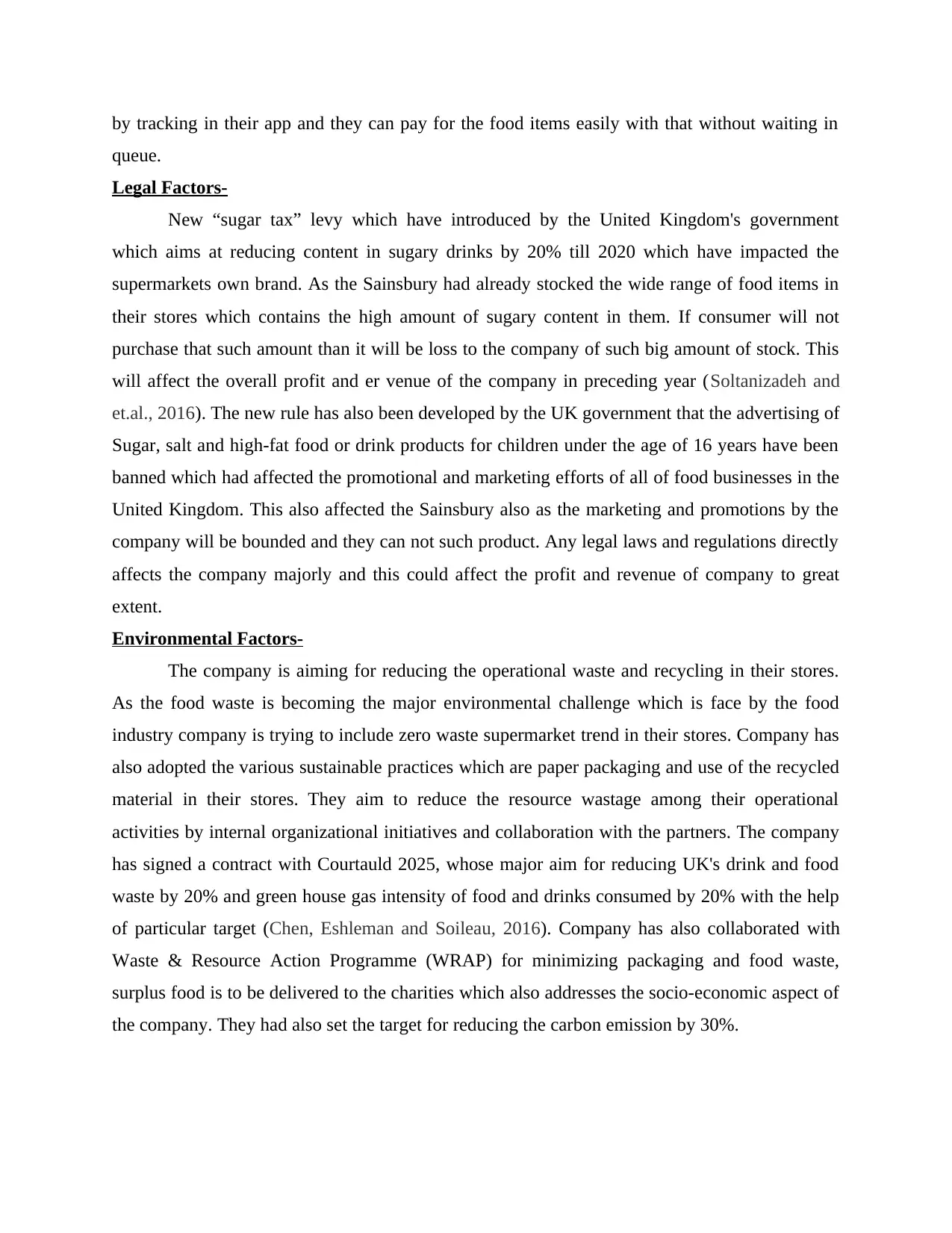
by tracking in their app and they can pay for the food items easily with that without waiting in
queue.
Legal Factors-
New “sugar tax” levy which have introduced by the United Kingdom's government
which aims at reducing content in sugary drinks by 20% till 2020 which have impacted the
supermarkets own brand. As the Sainsbury had already stocked the wide range of food items in
their stores which contains the high amount of sugary content in them. If consumer will not
purchase that such amount than it will be loss to the company of such big amount of stock. This
will affect the overall profit and er venue of the company in preceding year (Soltanizadeh and
et.al., 2016). The new rule has also been developed by the UK government that the advertising of
Sugar, salt and high-fat food or drink products for children under the age of 16 years have been
banned which had affected the promotional and marketing efforts of all of food businesses in the
United Kingdom. This also affected the Sainsbury also as the marketing and promotions by the
company will be bounded and they can not such product. Any legal laws and regulations directly
affects the company majorly and this could affect the profit and revenue of company to great
extent.
Environmental Factors-
The company is aiming for reducing the operational waste and recycling in their stores.
As the food waste is becoming the major environmental challenge which is face by the food
industry company is trying to include zero waste supermarket trend in their stores. Company has
also adopted the various sustainable practices which are paper packaging and use of the recycled
material in their stores. They aim to reduce the resource wastage among their operational
activities by internal organizational initiatives and collaboration with the partners. The company
has signed a contract with Courtauld 2025, whose major aim for reducing UK's drink and food
waste by 20% and green house gas intensity of food and drinks consumed by 20% with the help
of particular target (Chen, Eshleman and Soileau, 2016). Company has also collaborated with
Waste & Resource Action Programme (WRAP) for minimizing packaging and food waste,
surplus food is to be delivered to the charities which also addresses the socio-economic aspect of
the company. They had also set the target for reducing the carbon emission by 30%.
queue.
Legal Factors-
New “sugar tax” levy which have introduced by the United Kingdom's government
which aims at reducing content in sugary drinks by 20% till 2020 which have impacted the
supermarkets own brand. As the Sainsbury had already stocked the wide range of food items in
their stores which contains the high amount of sugary content in them. If consumer will not
purchase that such amount than it will be loss to the company of such big amount of stock. This
will affect the overall profit and er venue of the company in preceding year (Soltanizadeh and
et.al., 2016). The new rule has also been developed by the UK government that the advertising of
Sugar, salt and high-fat food or drink products for children under the age of 16 years have been
banned which had affected the promotional and marketing efforts of all of food businesses in the
United Kingdom. This also affected the Sainsbury also as the marketing and promotions by the
company will be bounded and they can not such product. Any legal laws and regulations directly
affects the company majorly and this could affect the profit and revenue of company to great
extent.
Environmental Factors-
The company is aiming for reducing the operational waste and recycling in their stores.
As the food waste is becoming the major environmental challenge which is face by the food
industry company is trying to include zero waste supermarket trend in their stores. Company has
also adopted the various sustainable practices which are paper packaging and use of the recycled
material in their stores. They aim to reduce the resource wastage among their operational
activities by internal organizational initiatives and collaboration with the partners. The company
has signed a contract with Courtauld 2025, whose major aim for reducing UK's drink and food
waste by 20% and green house gas intensity of food and drinks consumed by 20% with the help
of particular target (Chen, Eshleman and Soileau, 2016). Company has also collaborated with
Waste & Resource Action Programme (WRAP) for minimizing packaging and food waste,
surplus food is to be delivered to the charities which also addresses the socio-economic aspect of
the company. They had also set the target for reducing the carbon emission by 30%.

P2 Analysation of internal environment and capabilities of the organization using the
appropriate framework-
SWOT Analysis :
SWOT Analysis of the J Sainsbury Plc is helpful in evaluating strength, weaknesses,
opportunities and threats which are associated with the business strategy and operation of
organization. It can be described below-
Strength-
It is the third largest supermarket chain in the United Kingdom. The company has 15.8%
of market share. The company has created the brand loyalty among the consumer by providing
quality products to their consumers. It had 1400 grocery stores across united Kingdom. The
company has strong balance sheet along with the consistent profitability. The company has
differentiated food proposition with the great quality. It is the great place for working with the
diverse employee. Company employee more than 150,000 people in their firm (Buckley and
Ghauri, 2015). Its business areas are also expanded form food and groceries to the other areas
also that is finance, energy and clothing. The diversity of company's portfolio has also been
increased as it takeover the Argos.
Weaknesses-
The company has single operating market. It works on the low profit margin in their food
business which renders the less profit to company on particular products. In 2017, the annual
profit of the company has been declined from 8.25%. Company also have risk from the brand
switching in-spite of all its loyalty program and promotions they still feel challenged to retain
their customers which should be sought out. The costing of the company is raising day by day as
more skilled and educated employees must be employed at the stores and other department so
that they can easily handle the customer which raises the costing of company.
Opportunities-
The company has many opportunities to expand its business across the domestic and
international expansion. Online grocery stores and the convenience stores can also be established
by the company for future growth so that they can deal with new trend in market and attract more
consumers. They can also use the technology analytics in their stores for helping the consumer's
insight (Buckley, Burton and Mirza, 2016). Company can expand itself to emerging countries
that can be India, China, Turkey, Russia and Brazil which containing the highest population
appropriate framework-
SWOT Analysis :
SWOT Analysis of the J Sainsbury Plc is helpful in evaluating strength, weaknesses,
opportunities and threats which are associated with the business strategy and operation of
organization. It can be described below-
Strength-
It is the third largest supermarket chain in the United Kingdom. The company has 15.8%
of market share. The company has created the brand loyalty among the consumer by providing
quality products to their consumers. It had 1400 grocery stores across united Kingdom. The
company has strong balance sheet along with the consistent profitability. The company has
differentiated food proposition with the great quality. It is the great place for working with the
diverse employee. Company employee more than 150,000 people in their firm (Buckley and
Ghauri, 2015). Its business areas are also expanded form food and groceries to the other areas
also that is finance, energy and clothing. The diversity of company's portfolio has also been
increased as it takeover the Argos.
Weaknesses-
The company has single operating market. It works on the low profit margin in their food
business which renders the less profit to company on particular products. In 2017, the annual
profit of the company has been declined from 8.25%. Company also have risk from the brand
switching in-spite of all its loyalty program and promotions they still feel challenged to retain
their customers which should be sought out. The costing of the company is raising day by day as
more skilled and educated employees must be employed at the stores and other department so
that they can easily handle the customer which raises the costing of company.
Opportunities-
The company has many opportunities to expand its business across the domestic and
international expansion. Online grocery stores and the convenience stores can also be established
by the company for future growth so that they can deal with new trend in market and attract more
consumers. They can also use the technology analytics in their stores for helping the consumer's
insight (Buckley, Burton and Mirza, 2016). Company can expand itself to emerging countries
that can be India, China, Turkey, Russia and Brazil which containing the highest population
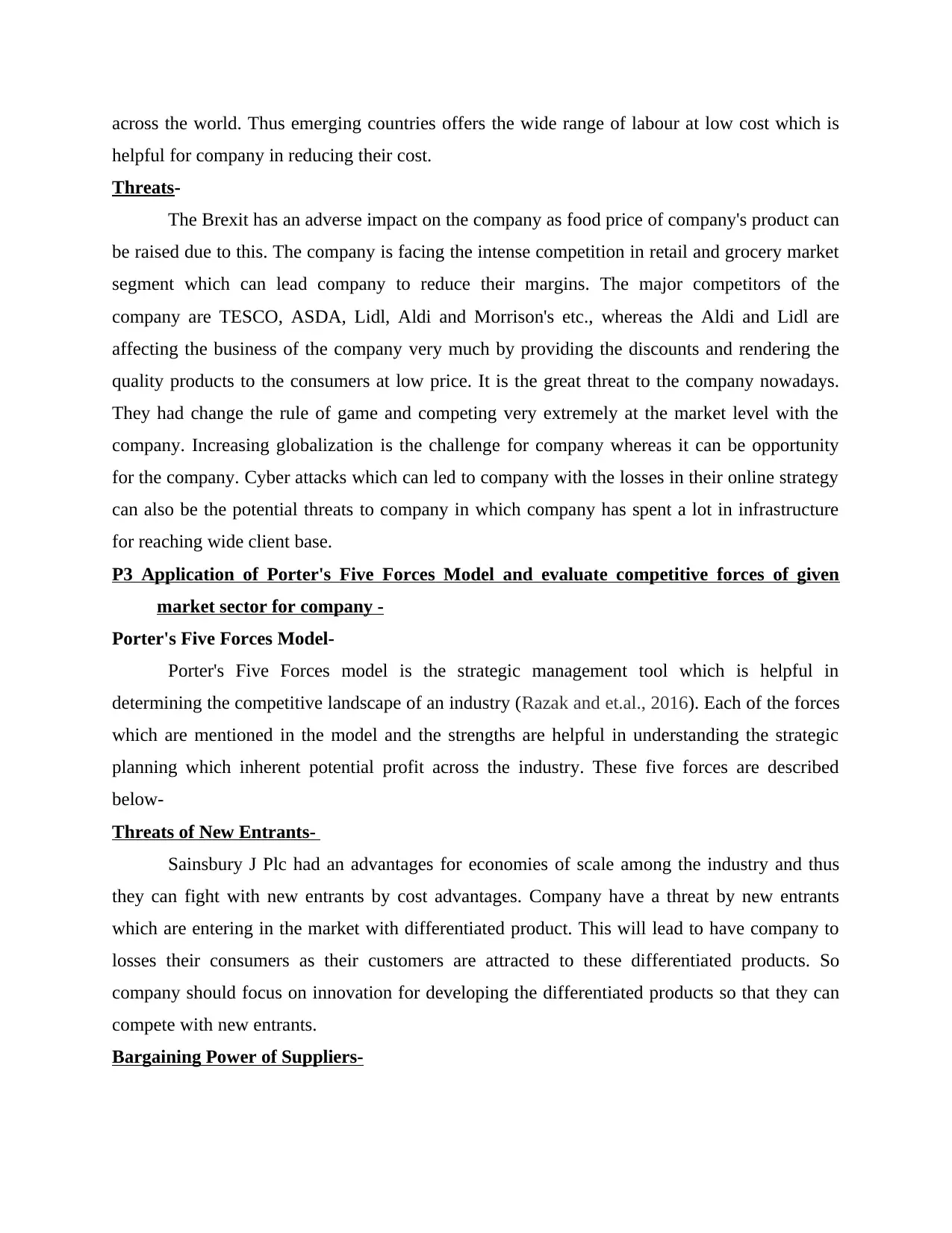
across the world. Thus emerging countries offers the wide range of labour at low cost which is
helpful for company in reducing their cost.
Threats-
The Brexit has an adverse impact on the company as food price of company's product can
be raised due to this. The company is facing the intense competition in retail and grocery market
segment which can lead company to reduce their margins. The major competitors of the
company are TESCO, ASDA, Lidl, Aldi and Morrison's etc., whereas the Aldi and Lidl are
affecting the business of the company very much by providing the discounts and rendering the
quality products to the consumers at low price. It is the great threat to the company nowadays.
They had change the rule of game and competing very extremely at the market level with the
company. Increasing globalization is the challenge for company whereas it can be opportunity
for the company. Cyber attacks which can led to company with the losses in their online strategy
can also be the potential threats to company in which company has spent a lot in infrastructure
for reaching wide client base.
P3 Application of Porter's Five Forces Model and evaluate competitive forces of given
market sector for company -
Porter's Five Forces Model-
Porter's Five Forces model is the strategic management tool which is helpful in
determining the competitive landscape of an industry (Razak and et.al., 2016). Each of the forces
which are mentioned in the model and the strengths are helpful in understanding the strategic
planning which inherent potential profit across the industry. These five forces are described
below-
Threats of New Entrants-
Sainsbury J Plc had an advantages for economies of scale among the industry and thus
they can fight with new entrants by cost advantages. Company have a threat by new entrants
which are entering in the market with differentiated product. This will lead to have company to
losses their consumers as their customers are attracted to these differentiated products. So
company should focus on innovation for developing the differentiated products so that they can
compete with new entrants.
Bargaining Power of Suppliers-
helpful for company in reducing their cost.
Threats-
The Brexit has an adverse impact on the company as food price of company's product can
be raised due to this. The company is facing the intense competition in retail and grocery market
segment which can lead company to reduce their margins. The major competitors of the
company are TESCO, ASDA, Lidl, Aldi and Morrison's etc., whereas the Aldi and Lidl are
affecting the business of the company very much by providing the discounts and rendering the
quality products to the consumers at low price. It is the great threat to the company nowadays.
They had change the rule of game and competing very extremely at the market level with the
company. Increasing globalization is the challenge for company whereas it can be opportunity
for the company. Cyber attacks which can led to company with the losses in their online strategy
can also be the potential threats to company in which company has spent a lot in infrastructure
for reaching wide client base.
P3 Application of Porter's Five Forces Model and evaluate competitive forces of given
market sector for company -
Porter's Five Forces Model-
Porter's Five Forces model is the strategic management tool which is helpful in
determining the competitive landscape of an industry (Razak and et.al., 2016). Each of the forces
which are mentioned in the model and the strengths are helpful in understanding the strategic
planning which inherent potential profit across the industry. These five forces are described
below-
Threats of New Entrants-
Sainsbury J Plc had an advantages for economies of scale among the industry and thus
they can fight with new entrants by cost advantages. Company have a threat by new entrants
which are entering in the market with differentiated product. This will lead to have company to
losses their consumers as their customers are attracted to these differentiated products. So
company should focus on innovation for developing the differentiated products so that they can
compete with new entrants.
Bargaining Power of Suppliers-
Paraphrase This Document
Need a fresh take? Get an instant paraphrase of this document with our AI Paraphraser
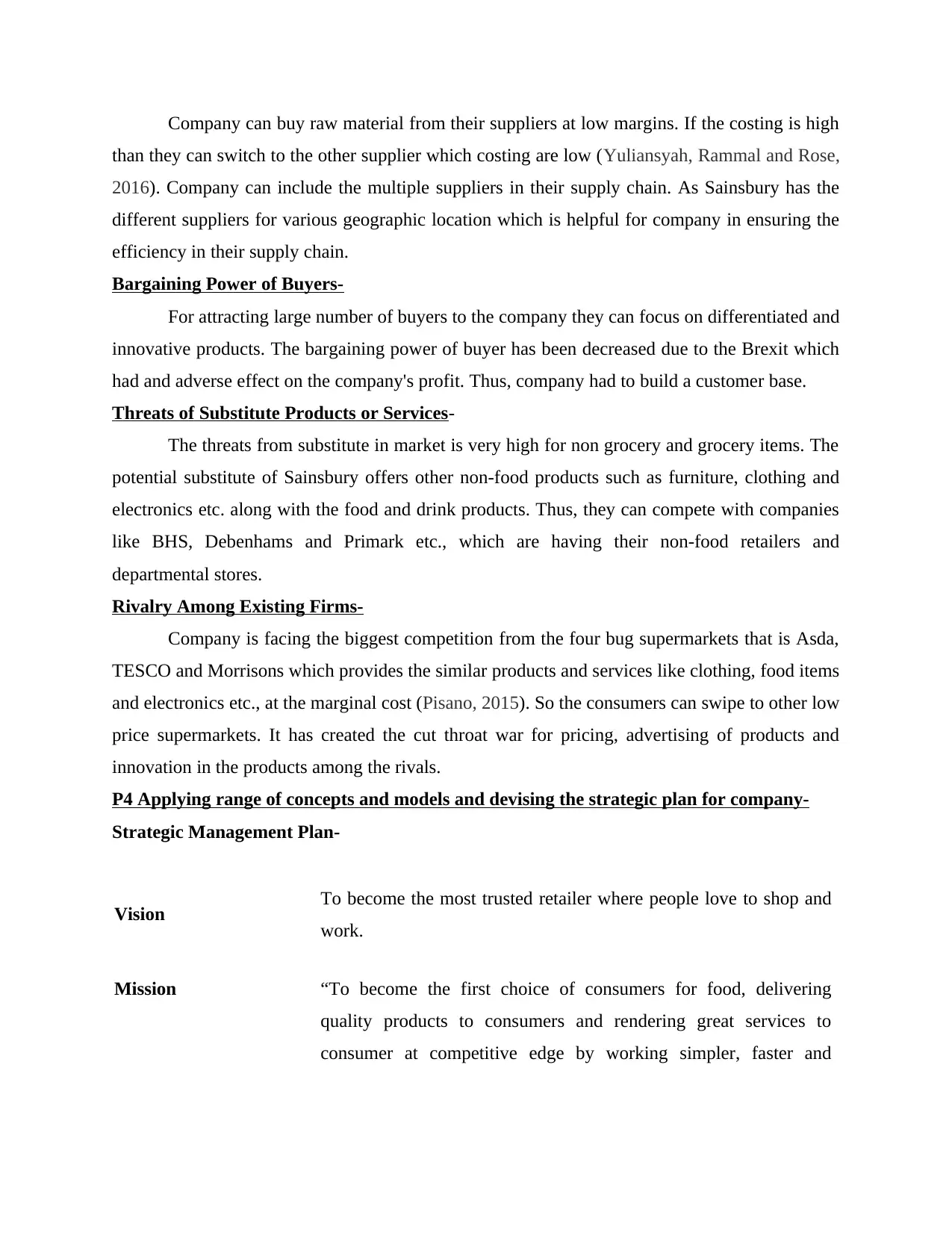
Company can buy raw material from their suppliers at low margins. If the costing is high
than they can switch to the other supplier which costing are low (Yuliansyah, Rammal and Rose,
2016). Company can include the multiple suppliers in their supply chain. As Sainsbury has the
different suppliers for various geographic location which is helpful for company in ensuring the
efficiency in their supply chain.
Bargaining Power of Buyers-
For attracting large number of buyers to the company they can focus on differentiated and
innovative products. The bargaining power of buyer has been decreased due to the Brexit which
had and adverse effect on the company's profit. Thus, company had to build a customer base.
Threats of Substitute Products or Services-
The threats from substitute in market is very high for non grocery and grocery items. The
potential substitute of Sainsbury offers other non-food products such as furniture, clothing and
electronics etc. along with the food and drink products. Thus, they can compete with companies
like BHS, Debenhams and Primark etc., which are having their non-food retailers and
departmental stores.
Rivalry Among Existing Firms-
Company is facing the biggest competition from the four bug supermarkets that is Asda,
TESCO and Morrisons which provides the similar products and services like clothing, food items
and electronics etc., at the marginal cost (Pisano, 2015). So the consumers can swipe to other low
price supermarkets. It has created the cut throat war for pricing, advertising of products and
innovation in the products among the rivals.
P4 Applying range of concepts and models and devising the strategic plan for company-
Strategic Management Plan-
Vision To become the most trusted retailer where people love to shop and
work.
Mission “To become the first choice of consumers for food, delivering
quality products to consumers and rendering great services to
consumer at competitive edge by working simpler, faster and
than they can switch to the other supplier which costing are low (Yuliansyah, Rammal and Rose,
2016). Company can include the multiple suppliers in their supply chain. As Sainsbury has the
different suppliers for various geographic location which is helpful for company in ensuring the
efficiency in their supply chain.
Bargaining Power of Buyers-
For attracting large number of buyers to the company they can focus on differentiated and
innovative products. The bargaining power of buyer has been decreased due to the Brexit which
had and adverse effect on the company's profit. Thus, company had to build a customer base.
Threats of Substitute Products or Services-
The threats from substitute in market is very high for non grocery and grocery items. The
potential substitute of Sainsbury offers other non-food products such as furniture, clothing and
electronics etc. along with the food and drink products. Thus, they can compete with companies
like BHS, Debenhams and Primark etc., which are having their non-food retailers and
departmental stores.
Rivalry Among Existing Firms-
Company is facing the biggest competition from the four bug supermarkets that is Asda,
TESCO and Morrisons which provides the similar products and services like clothing, food items
and electronics etc., at the marginal cost (Pisano, 2015). So the consumers can swipe to other low
price supermarkets. It has created the cut throat war for pricing, advertising of products and
innovation in the products among the rivals.
P4 Applying range of concepts and models and devising the strategic plan for company-
Strategic Management Plan-
Vision To become the most trusted retailer where people love to shop and
work.
Mission “To become the first choice of consumers for food, delivering
quality products to consumers and rendering great services to
consumer at competitive edge by working simpler, faster and
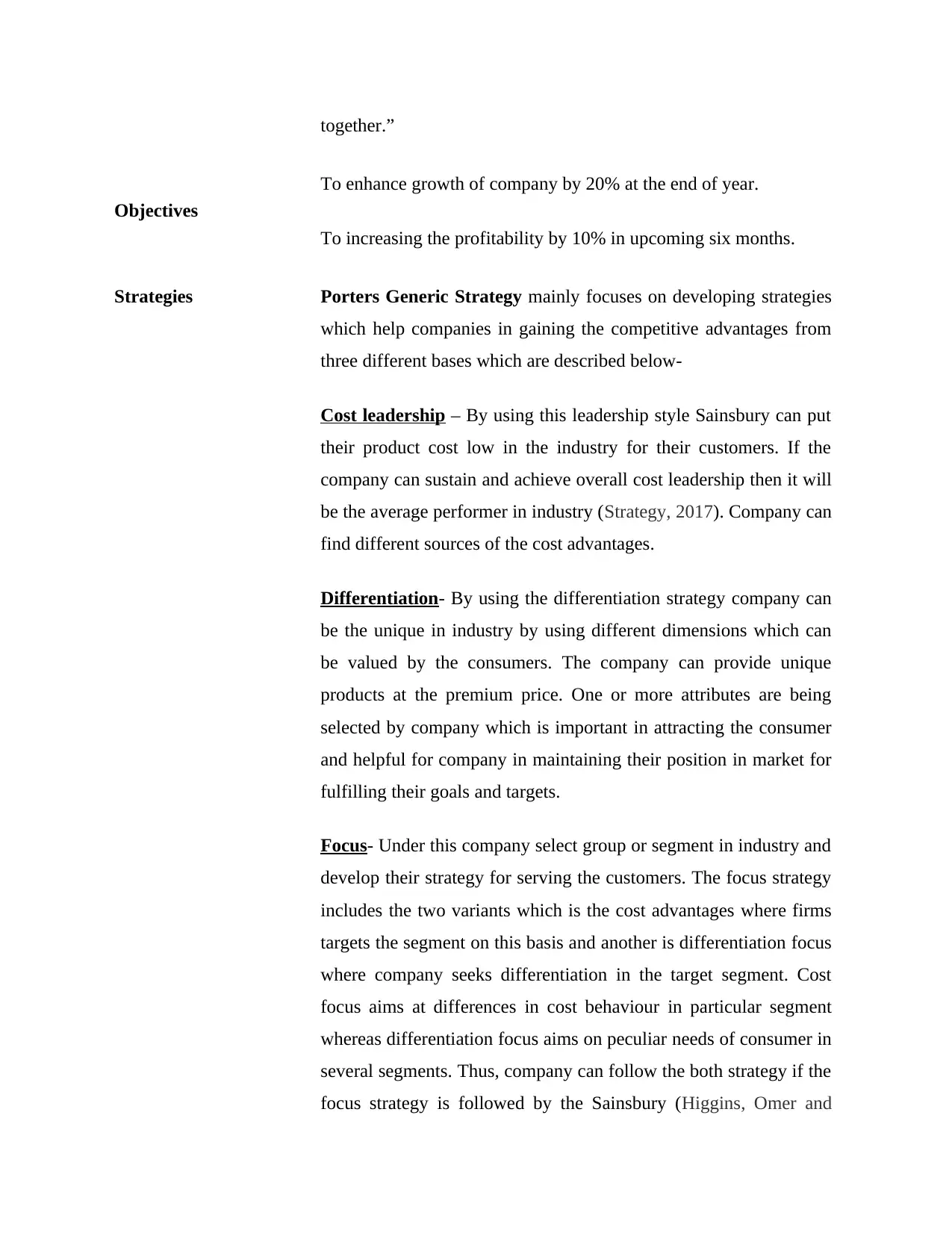
together.”
Objectives
To enhance growth of company by 20% at the end of year.
To increasing the profitability by 10% in upcoming six months.
Strategies Porters Generic Strategy mainly focuses on developing strategies
which help companies in gaining the competitive advantages from
three different bases which are described below-
Cost leadership – By using this leadership style Sainsbury can put
their product cost low in the industry for their customers. If the
company can sustain and achieve overall cost leadership then it will
be the average performer in industry (Strategy, 2017). Company can
find different sources of the cost advantages.
Differentiation- By using the differentiation strategy company can
be the unique in industry by using different dimensions which can
be valued by the consumers. The company can provide unique
products at the premium price. One or more attributes are being
selected by company which is important in attracting the consumer
and helpful for company in maintaining their position in market for
fulfilling their goals and targets.
Focus- Under this company select group or segment in industry and
develop their strategy for serving the customers. The focus strategy
includes the two variants which is the cost advantages where firms
targets the segment on this basis and another is differentiation focus
where company seeks differentiation in the target segment. Cost
focus aims at differences in cost behaviour in particular segment
whereas differentiation focus aims on peculiar needs of consumer in
several segments. Thus, company can follow the both strategy if the
focus strategy is followed by the Sainsbury (Higgins, Omer and
Objectives
To enhance growth of company by 20% at the end of year.
To increasing the profitability by 10% in upcoming six months.
Strategies Porters Generic Strategy mainly focuses on developing strategies
which help companies in gaining the competitive advantages from
three different bases which are described below-
Cost leadership – By using this leadership style Sainsbury can put
their product cost low in the industry for their customers. If the
company can sustain and achieve overall cost leadership then it will
be the average performer in industry (Strategy, 2017). Company can
find different sources of the cost advantages.
Differentiation- By using the differentiation strategy company can
be the unique in industry by using different dimensions which can
be valued by the consumers. The company can provide unique
products at the premium price. One or more attributes are being
selected by company which is important in attracting the consumer
and helpful for company in maintaining their position in market for
fulfilling their goals and targets.
Focus- Under this company select group or segment in industry and
develop their strategy for serving the customers. The focus strategy
includes the two variants which is the cost advantages where firms
targets the segment on this basis and another is differentiation focus
where company seeks differentiation in the target segment. Cost
focus aims at differences in cost behaviour in particular segment
whereas differentiation focus aims on peculiar needs of consumer in
several segments. Thus, company can follow the both strategy if the
focus strategy is followed by the Sainsbury (Higgins, Omer and
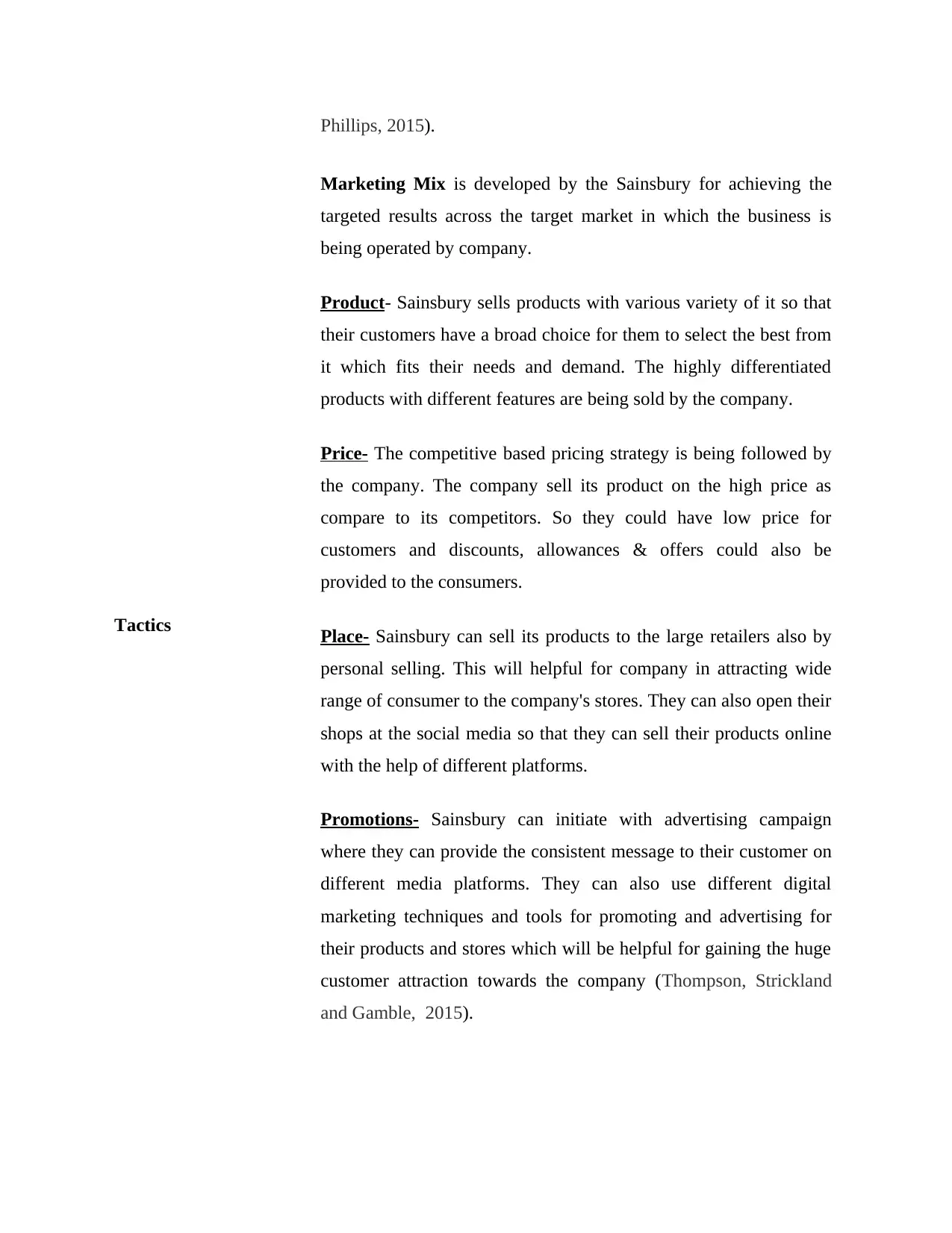
Phillips, 2015).
Tactics
Marketing Mix is developed by the Sainsbury for achieving the
targeted results across the target market in which the business is
being operated by company.
Product- Sainsbury sells products with various variety of it so that
their customers have a broad choice for them to select the best from
it which fits their needs and demand. The highly differentiated
products with different features are being sold by the company.
Price- The competitive based pricing strategy is being followed by
the company. The company sell its product on the high price as
compare to its competitors. So they could have low price for
customers and discounts, allowances & offers could also be
provided to the consumers.
Place- Sainsbury can sell its products to the large retailers also by
personal selling. This will helpful for company in attracting wide
range of consumer to the company's stores. They can also open their
shops at the social media so that they can sell their products online
with the help of different platforms.
Promotions- Sainsbury can initiate with advertising campaign
where they can provide the consistent message to their customer on
different media platforms. They can also use different digital
marketing techniques and tools for promoting and advertising for
their products and stores which will be helpful for gaining the huge
customer attraction towards the company (Thompson, Strickland
and Gamble, 2015).
Tactics
Marketing Mix is developed by the Sainsbury for achieving the
targeted results across the target market in which the business is
being operated by company.
Product- Sainsbury sells products with various variety of it so that
their customers have a broad choice for them to select the best from
it which fits their needs and demand. The highly differentiated
products with different features are being sold by the company.
Price- The competitive based pricing strategy is being followed by
the company. The company sell its product on the high price as
compare to its competitors. So they could have low price for
customers and discounts, allowances & offers could also be
provided to the consumers.
Place- Sainsbury can sell its products to the large retailers also by
personal selling. This will helpful for company in attracting wide
range of consumer to the company's stores. They can also open their
shops at the social media so that they can sell their products online
with the help of different platforms.
Promotions- Sainsbury can initiate with advertising campaign
where they can provide the consistent message to their customer on
different media platforms. They can also use different digital
marketing techniques and tools for promoting and advertising for
their products and stores which will be helpful for gaining the huge
customer attraction towards the company (Thompson, Strickland
and Gamble, 2015).
Secure Best Marks with AI Grader
Need help grading? Try our AI Grader for instant feedback on your assignments.
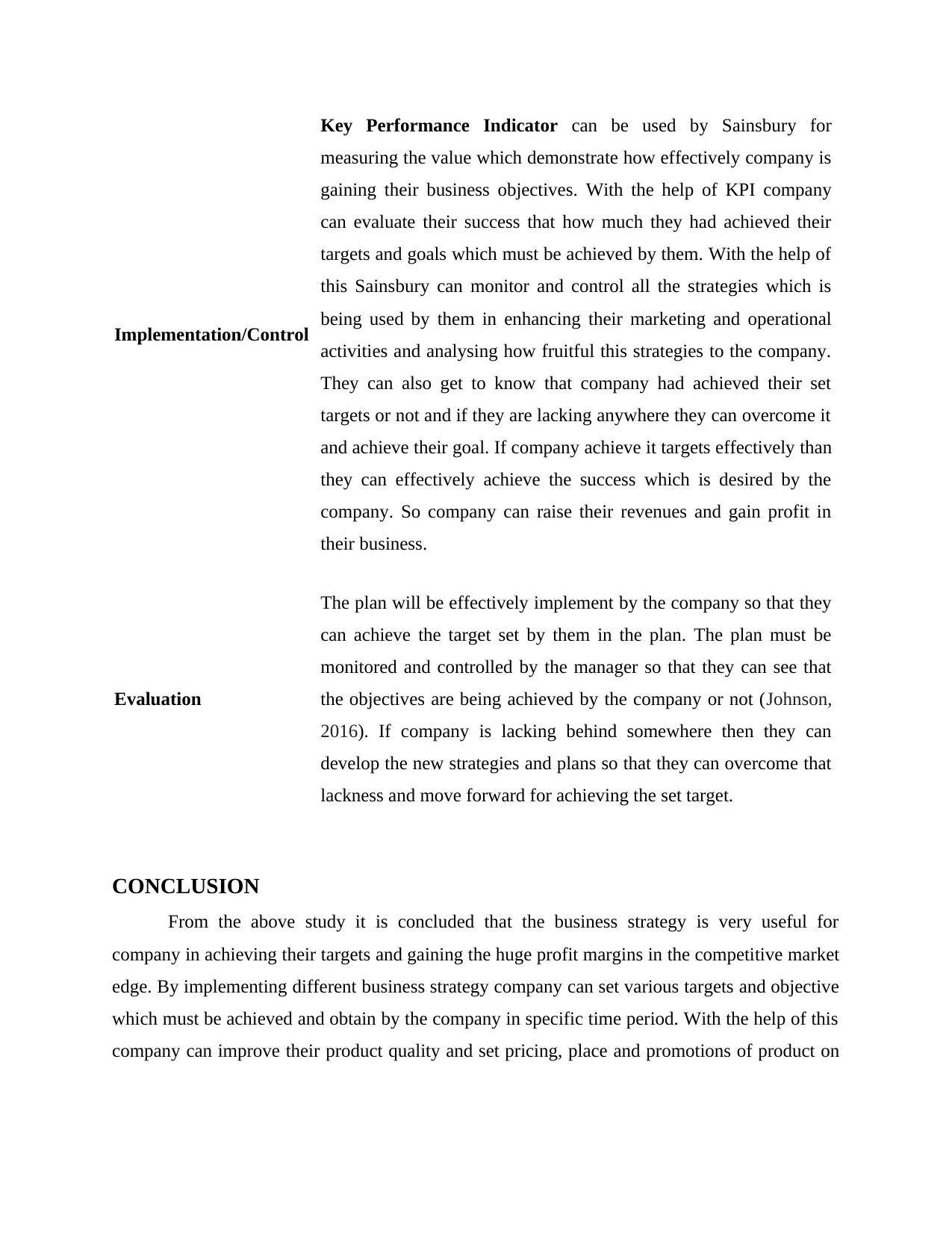
Implementation/Control
Key Performance Indicator can be used by Sainsbury for
measuring the value which demonstrate how effectively company is
gaining their business objectives. With the help of KPI company
can evaluate their success that how much they had achieved their
targets and goals which must be achieved by them. With the help of
this Sainsbury can monitor and control all the strategies which is
being used by them in enhancing their marketing and operational
activities and analysing how fruitful this strategies to the company.
They can also get to know that company had achieved their set
targets or not and if they are lacking anywhere they can overcome it
and achieve their goal. If company achieve it targets effectively than
they can effectively achieve the success which is desired by the
company. So company can raise their revenues and gain profit in
their business.
Evaluation
The plan will be effectively implement by the company so that they
can achieve the target set by them in the plan. The plan must be
monitored and controlled by the manager so that they can see that
the objectives are being achieved by the company or not (Johnson,
2016). If company is lacking behind somewhere then they can
develop the new strategies and plans so that they can overcome that
lackness and move forward for achieving the set target.
CONCLUSION
From the above study it is concluded that the business strategy is very useful for
company in achieving their targets and gaining the huge profit margins in the competitive market
edge. By implementing different business strategy company can set various targets and objective
which must be achieved and obtain by the company in specific time period. With the help of this
company can improve their product quality and set pricing, place and promotions of product on
Key Performance Indicator can be used by Sainsbury for
measuring the value which demonstrate how effectively company is
gaining their business objectives. With the help of KPI company
can evaluate their success that how much they had achieved their
targets and goals which must be achieved by them. With the help of
this Sainsbury can monitor and control all the strategies which is
being used by them in enhancing their marketing and operational
activities and analysing how fruitful this strategies to the company.
They can also get to know that company had achieved their set
targets or not and if they are lacking anywhere they can overcome it
and achieve their goal. If company achieve it targets effectively than
they can effectively achieve the success which is desired by the
company. So company can raise their revenues and gain profit in
their business.
Evaluation
The plan will be effectively implement by the company so that they
can achieve the target set by them in the plan. The plan must be
monitored and controlled by the manager so that they can see that
the objectives are being achieved by the company or not (Johnson,
2016). If company is lacking behind somewhere then they can
develop the new strategies and plans so that they can overcome that
lackness and move forward for achieving the set target.
CONCLUSION
From the above study it is concluded that the business strategy is very useful for
company in achieving their targets and gaining the huge profit margins in the competitive market
edge. By implementing different business strategy company can set various targets and objective
which must be achieved and obtain by the company in specific time period. With the help of this
company can improve their product quality and set pricing, place and promotions of product on
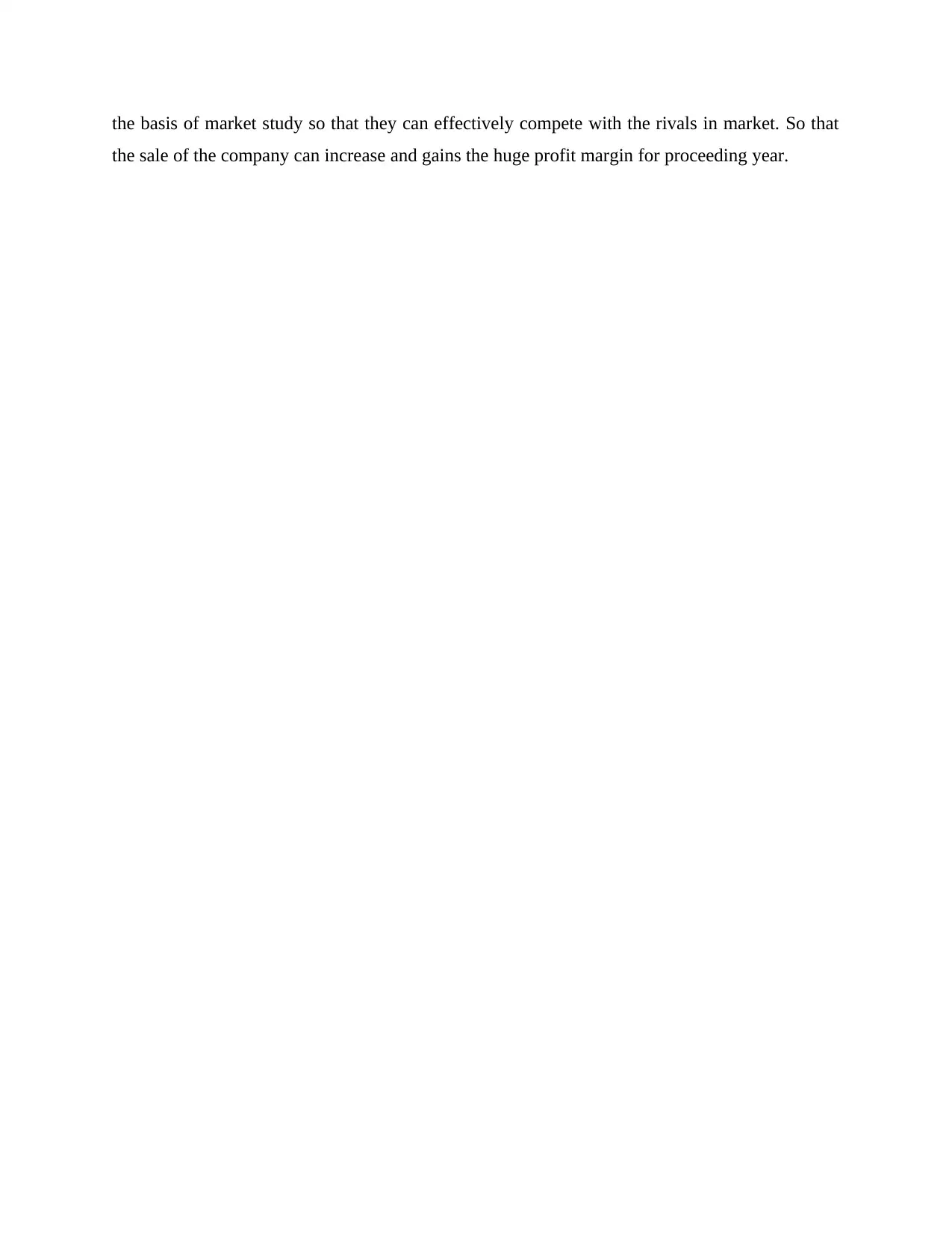
the basis of market study so that they can effectively compete with the rivals in market. So that
the sale of the company can increase and gains the huge profit margin for proceeding year.
the sale of the company can increase and gains the huge profit margin for proceeding year.
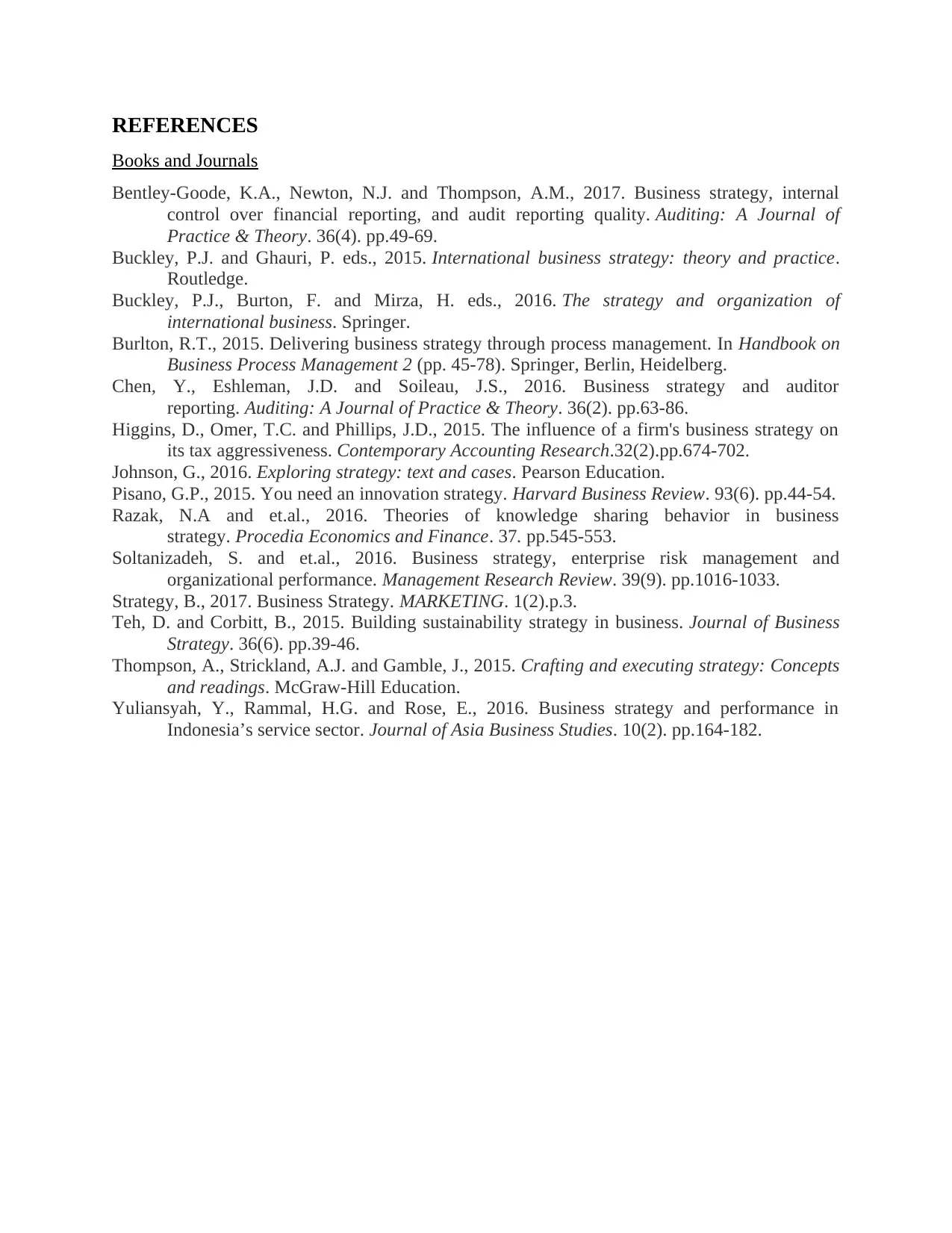
REFERENCES
Books and Journals
Bentley-Goode, K.A., Newton, N.J. and Thompson, A.M., 2017. Business strategy, internal
control over financial reporting, and audit reporting quality. Auditing: A Journal of
Practice & Theory. 36(4). pp.49-69.
Buckley, P.J. and Ghauri, P. eds., 2015. International business strategy: theory and practice.
Routledge.
Buckley, P.J., Burton, F. and Mirza, H. eds., 2016. The strategy and organization of
international business. Springer.
Burlton, R.T., 2015. Delivering business strategy through process management. In Handbook on
Business Process Management 2 (pp. 45-78). Springer, Berlin, Heidelberg.
Chen, Y., Eshleman, J.D. and Soileau, J.S., 2016. Business strategy and auditor
reporting. Auditing: A Journal of Practice & Theory. 36(2). pp.63-86.
Higgins, D., Omer, T.C. and Phillips, J.D., 2015. The influence of a firm's business strategy on
its tax aggressiveness. Contemporary Accounting Research.32(2).pp.674-702.
Johnson, G., 2016. Exploring strategy: text and cases. Pearson Education.
Pisano, G.P., 2015. You need an innovation strategy. Harvard Business Review. 93(6). pp.44-54.
Razak, N.A and et.al., 2016. Theories of knowledge sharing behavior in business
strategy. Procedia Economics and Finance. 37. pp.545-553.
Soltanizadeh, S. and et.al., 2016. Business strategy, enterprise risk management and
organizational performance. Management Research Review. 39(9). pp.1016-1033.
Strategy, B., 2017. Business Strategy. MARKETING. 1(2).p.3.
Teh, D. and Corbitt, B., 2015. Building sustainability strategy in business. Journal of Business
Strategy. 36(6). pp.39-46.
Thompson, A., Strickland, A.J. and Gamble, J., 2015. Crafting and executing strategy: Concepts
and readings. McGraw-Hill Education.
Yuliansyah, Y., Rammal, H.G. and Rose, E., 2016. Business strategy and performance in
Indonesia’s service sector. Journal of Asia Business Studies. 10(2). pp.164-182.
Books and Journals
Bentley-Goode, K.A., Newton, N.J. and Thompson, A.M., 2017. Business strategy, internal
control over financial reporting, and audit reporting quality. Auditing: A Journal of
Practice & Theory. 36(4). pp.49-69.
Buckley, P.J. and Ghauri, P. eds., 2015. International business strategy: theory and practice.
Routledge.
Buckley, P.J., Burton, F. and Mirza, H. eds., 2016. The strategy and organization of
international business. Springer.
Burlton, R.T., 2015. Delivering business strategy through process management. In Handbook on
Business Process Management 2 (pp. 45-78). Springer, Berlin, Heidelberg.
Chen, Y., Eshleman, J.D. and Soileau, J.S., 2016. Business strategy and auditor
reporting. Auditing: A Journal of Practice & Theory. 36(2). pp.63-86.
Higgins, D., Omer, T.C. and Phillips, J.D., 2015. The influence of a firm's business strategy on
its tax aggressiveness. Contemporary Accounting Research.32(2).pp.674-702.
Johnson, G., 2016. Exploring strategy: text and cases. Pearson Education.
Pisano, G.P., 2015. You need an innovation strategy. Harvard Business Review. 93(6). pp.44-54.
Razak, N.A and et.al., 2016. Theories of knowledge sharing behavior in business
strategy. Procedia Economics and Finance. 37. pp.545-553.
Soltanizadeh, S. and et.al., 2016. Business strategy, enterprise risk management and
organizational performance. Management Research Review. 39(9). pp.1016-1033.
Strategy, B., 2017. Business Strategy. MARKETING. 1(2).p.3.
Teh, D. and Corbitt, B., 2015. Building sustainability strategy in business. Journal of Business
Strategy. 36(6). pp.39-46.
Thompson, A., Strickland, A.J. and Gamble, J., 2015. Crafting and executing strategy: Concepts
and readings. McGraw-Hill Education.
Yuliansyah, Y., Rammal, H.G. and Rose, E., 2016. Business strategy and performance in
Indonesia’s service sector. Journal of Asia Business Studies. 10(2). pp.164-182.
1 out of 13
Related Documents
Your All-in-One AI-Powered Toolkit for Academic Success.
+13062052269
info@desklib.com
Available 24*7 on WhatsApp / Email
![[object Object]](/_next/static/media/star-bottom.7253800d.svg)
Unlock your academic potential
© 2024 | Zucol Services PVT LTD | All rights reserved.





